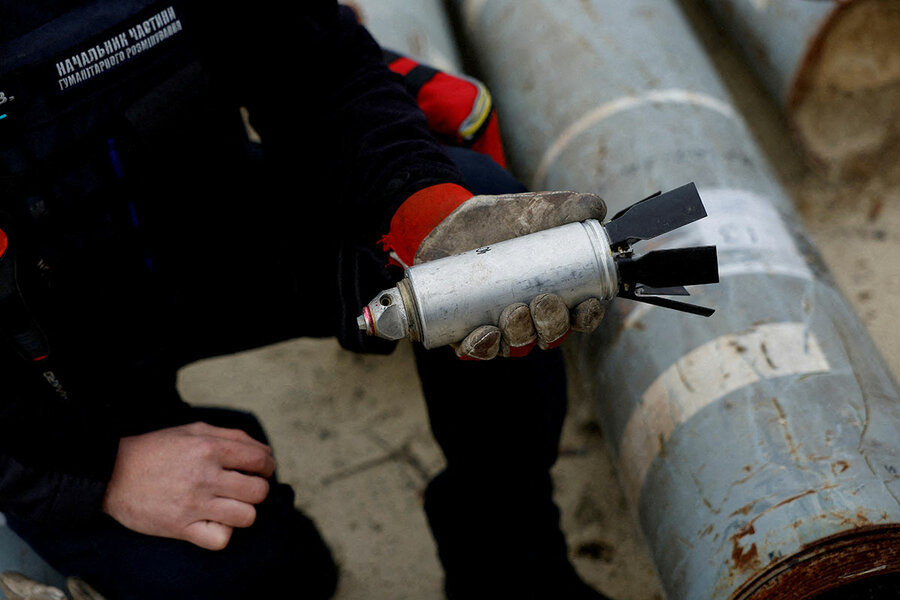US cluster bombs for Ukraine – a game changer or a mistake?
Loading...
| Washington
Cluster munitions can be seen as an imperfect response in a war currently lacking perfect answers. Ukraine’s slow-moving counteroffensive needed a jolt and ammunition to sustain it. Both needs will be helped by the weapons that President Joe Biden agreed on Friday to send to Ukraine, say military experts.
But the weapons also carry obvious risks. They can be highly dangerous for civilians, and humanitarian groups have already objected to the announcement. Many of the key countries supporting Ukraine – such as the United Kingdom and Germany – are party to the Oslo Convention on Cluster Munitions, a treaty banning their use.
Why We Wrote This
As the U.S. prepares to share cluster munitions with Ukraine for use against Russian troops, the ethics of a controversial weapon (banned by more than half of nations) have come under scrutiny.
Ultimately, President Biden decided that Ukraine can best determine how to protect its own civilians and that the risk of more unexploded ordnance is outweighed by the risk of not liberating more territory, and civilians, from the Russians. There’s little moral clarity in such an assessment, but that’s often the case in war.
“There isn’t a good answer here,” says a former artillery officer who is now an analyst at the Center for Strategic and International Studies, a Washington think tank. “Either he gives these weapons, with the humanitarian concerns, or he doesn’t, and the Ukrainian offensive is less effective.”
President Joe Biden’s decision last Friday to send Ukraine cluster munitions didn’t come easily.
It took 42 U.S. aid packages, a request from Ukraine, another from four leading Republicans in Congress, and a unanimous recommendation from the National Security Council before the president was persuaded.
“It took me a while to be convinced to do it,” President Biden said in an interview with CNN last week. “But the main thing is they either have the weapons to stop the Russians now … or they don’t.”
Why We Wrote This
As the U.S. prepares to share cluster munitions with Ukraine for use against Russian troops, the ethics of a controversial weapon (banned by more than half of nations) have come under scrutiny.
Cluster munitions can be seen as an imperfect response in a war currently lacking perfect answers. Ukraine’s counteroffensive has wrenched free less than 160 square miles after more than a month of fighting. The slow pace needed a jolt and ammunition to sustain it in the long term, say military experts. Cluster munitions will help with both, they add.
But the weapons also carry obvious risks, including to alliance unity. Many of the key countries supporting Ukraine – such as the United Kingdom and Germany – are party to the Oslo Convention on Cluster Munitions, a treaty banning their use. The controversial weapons can be highly dangerous for civilians, and humanitarian groups have already objected to the announcement.
Ultimately, the choice to send cluster munitions, or cluster bombs, to Ukraine could be seen as a kind of resignation. The president decided that Ukraine can best determine how to protect its own civilians and that the risk of more unexploded ordnance is outweighed by the risk of not liberating more territory, and civilians, from the Russians. There’s little moral clarity in such an assessment, but that’s often the case in war.
“There isn’t a good answer here,” says Mark Cancian, a former artillery officer who is now an analyst at the Center for Strategic and International Studies, a Washington think tank. “Either he gives these weapons, with the humanitarian concerns, or he doesn’t, and the Ukrainian offensive is less effective.”
An ammunition shortage
Speaking from the White House and Pentagon podiums last week, administration officials came prepared with points and counterpoints.
Their arguments fell into four main buckets. The first is that Russia has throughout the war used rocket-fired cluster munitions to attack Ukraine, which is now only using these weapons in self defense. The second is that Kyiv has committed in writing to only use the weapons on its own territory and not to fire them in densely populated or urban areas.
Additionally, they argued that Russia’s cluster munitions have a much higher dud rate – important because shells that don’t explode at first can kill civilians later – than those Ukraine will receive.
The final point may be the clearest. Without these supplies, Ukraine could face an ammunition shortage that would hamstring its counteroffensive. Cluster munitions will help them get through the crunch.
American and European defense industries – unprepared for an arduous war like Ukraine’s – have been ramping up to meet its needs since last February. The United States has already committed 2 million 155 mm shells, in addition to hundreds of thousands from other partners, but it hasn’t been enough.
Cluster munitions include dozens of bomblets inside a larger artillery shell. These kill more adversaries than individual rounds, allowing fewer shells to be fired overall and helping sustain the war effort while America’s industrial base tries to catch up.
Supporters add that these are exactly the kinds of munitions Ukraine needs in the current stage of the war. Russian defensive lines are nearly 20 miles thick in most areas and have multiple layers of minefields, trenches, and antitank structures, let alone Russian forces. These weapons will allow Ukraine to strike a more diffuse target – and with a relatively high degree of accuracy, at least according to Colin Kahl, under secretary of Defense for policy. He said the cluster munitions Ukraine will receive have a dud rate under 2.35%.
“A cluster munition is not a cluster munition,” said Dr. Kahl, speaking from the Pentagon briefing room last Friday. “There are big differences between them.”
Risk to civilians
Dr. Kahl said that 2.35% is based on five Department of Defense studies from 1998 to 2020. But the tests themselves are classified, and there are no plans to make them publicly available.
All of this adds to the skepticism of humanitarian groups, who warn that cluster bombs have already killed and will kill more civilians in this conflict.
A report from Human Rights Watch, released just before the administration’s announcement last week, reported that Ukrainian use of cluster munitions in the siege of Izium last fall resulted in eight civilian deaths and 15 more injuries. The Ukrainian government, which has previously received cluster munitions from Turkey, denied the findings.
Mary Wareham, advocacy director of Human Rights Watch’s arms division, is unconvinced by Dr. Kahl’s claim that not all cluster munitions are the same. “There’s good cluster munitions and there’s bad cluster munitions,” parrots Ms. Wareham. “This is what U.S. officials have tried to argue for years.”
In the past, the dud rate for U.S. cluster munitions has turned out to be higher than projected, causing civilian and soldier harm. During the first Gulf War in 1991, about 10% of all U.S. soldiers killed lost their lives from friendly fire unexploded ordnance.
There are different kinds of munitions testing, with varying levels of accuracy, and tests rarely project actual battlefield numbers. The bomblets inside cluster munitions are meant to explode perpendicular to the target. If weather conditions alter their orientation, or the ground is soft or uneven, the munitions are more likely to end up as duds.
The dud rate of the M42 munition – which is reportedly being sent to Ukraine – has been above 14%. About half of the dud munitions are active, meaning they can explode later. And there’s no way to tell whether a dud is truly a dud or a bomb waiting to go off, complicating the eventual task of clearing minefields.
“Adding [cluster munitions] to that problem makes it more time consuming, makes it more challenging, makes it more dangerous, because you can’t move the submunitions,” says Mark Hiznay, associate director of Human Rights Watch’s arms division. “They all have to be destroyed in place.”
To this, Ukrainians respond that de-mining will already take years, if not decades. The government’s goal right now is to liberate territory. They’ll take everything they can get to accomplish it.
“Our calculus is simple: Having them is less risky than not having these weapons,” says Yuriy Sak, an adviser to Ukraine’s minister of defense.
Some of the worst mass-casualty attacks of the war have been inflicted by Russian cluster bombs. The bombing of a railway station last April in the eastern city of Kramatorsk killed more than 60 and injured more than 150. A mother and daughter lost their legs. The story soon became a symbol of Russia’s indiscriminate attacks on Ukrainian civilians.
Regular Ukrainians are unlikely to be familiar with the technical side of the weapons, says Mr. Sak. But they know cluster munitions.
“If you ask an ordinary Ukrainian in the street what do you think about Ukraine getting cluster munitions I’d probably guess that their answer would be, ‘it’s about [expletive] time,’” he says.









